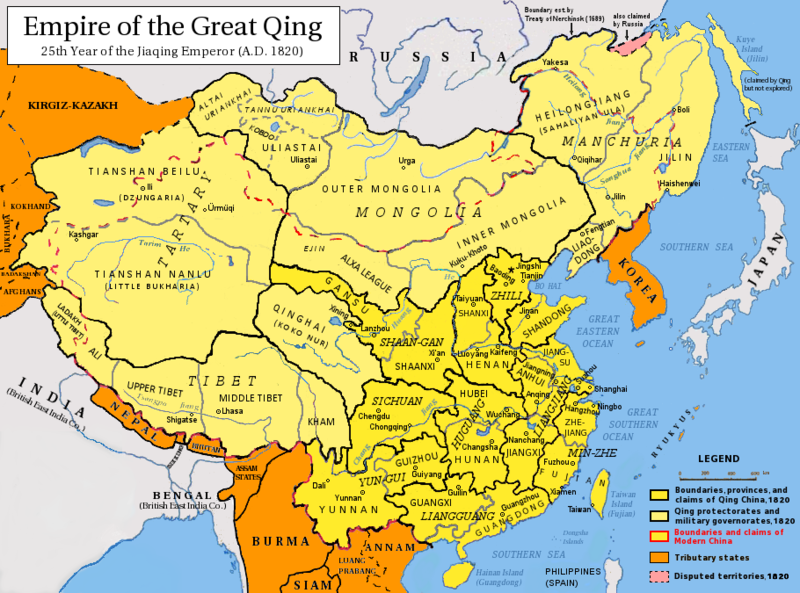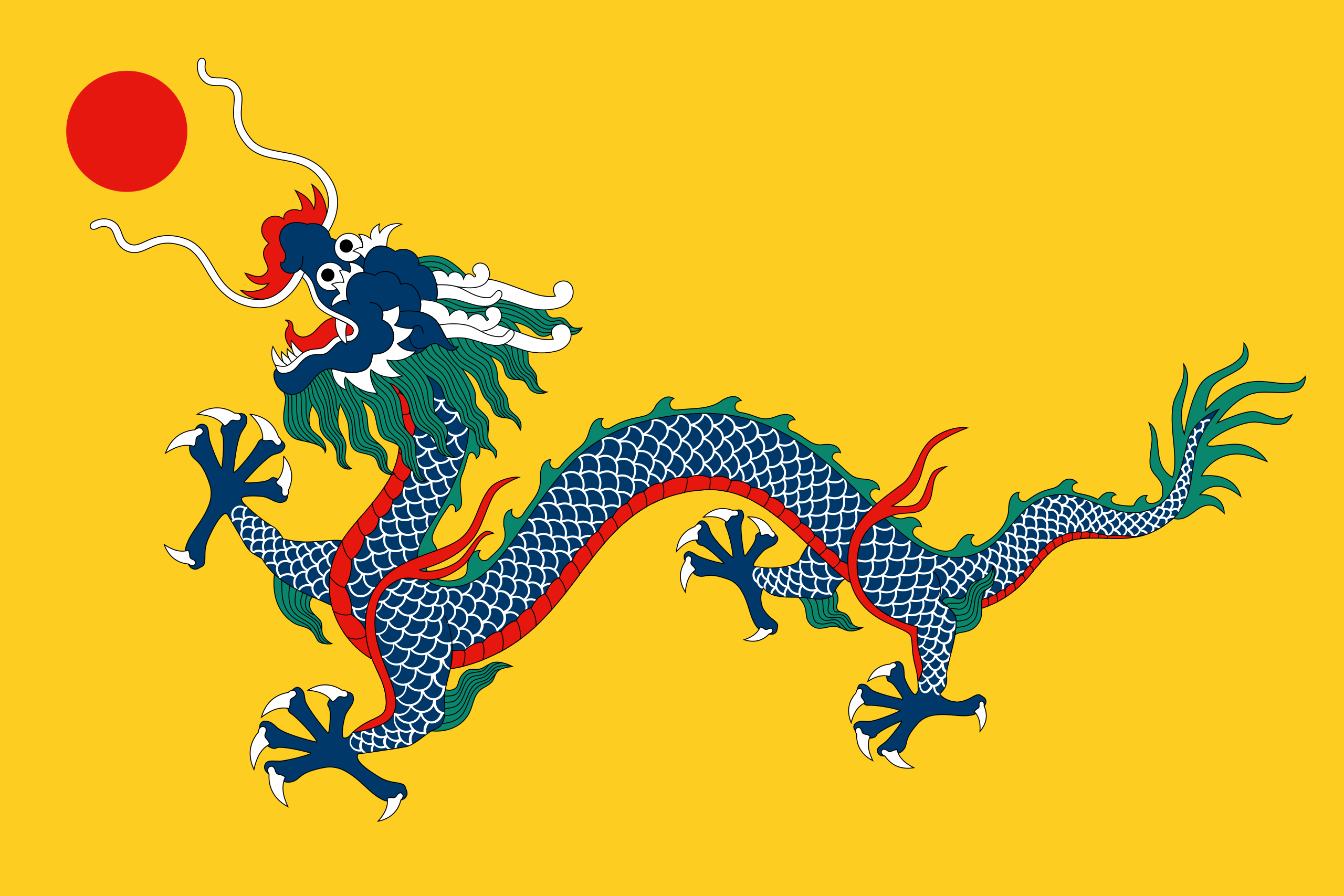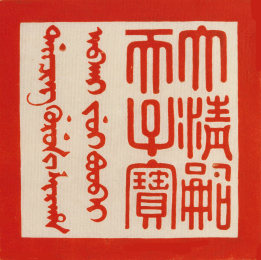More languages
More actions
- Not to be confused with Qin dynasty
Great Qing 清 (qīng)
ᡩᠠᡳ᠌ᠴᡳᠩ ᡤᡠᡵᡠᠨ
གྲེཨཏ་ཆིང1636–1912  The Qing Dynasty in 1820 C.E.
The Qing Dynasty in 1820 C.E.Capital and largest cityBeijing Common languages Mandarin, Mongolian, Manchu, Tibetan Dominant mode of production Feudalism Government Absolute monarchy (1636–1911)
Constitutional monarchy (1911–1912)History • Established1636 • Dissolution1912 Area • Total14,700,000 km² Population • 1912 estimate432,000,000
The Qing dynasty was the last dynasty to control China. It was established in 1636 by Hong Taiji, an ethnic Manchu,[1] as a successor to the Later Jin dynasty. While initially isolated to Manchuria (Northeastern China), the fall of the Ming dynasty in 1644 allowed the Qing to spread all throughout China and beyond. It stayed in power until the Xinhai Revolution of 1912, a bourgeois revolution which led to the creation of the Republic of China.The dynasty suffered from the imperialism of Japan and Europe and lost Hong Kong to Britain after the First Opium War in 1839.[2] In 1895, the Qing dynasty lost control over Taiwan and Korea in the First Sino-Japanese War when they were taken over by Japan.[3] The Boxer Rebellion at the turn of the century attempted to reestablish China's sovereignty but was crushed by a Western military alliance which included the United States, Austria-Hungary, Britain, France, and others.[4]
History
Pre-colonial
In the early 1700s, China produced 35% of the world's GDP and printed half the world's books. European countries bought Chinese porcelain, silk, and tea with gold, leading the British to sell over 30,000 tons of silver to China.[5]
Early Western influence
The British began trafficking opium into China in the 18th century to reverse the flow of silver. In 1729, the emperor banned opium imports, which were then about 14 tons per year. However, the trade continued and reached 320 tons per year by 1799.[5]
The USA joined the opium trade in 1784,[5] and U.S. capitalists created a factory in Guangzhou in 1801.[6] Annual opium imports reached 2,800 tons per year in 1838, costing China 4,000 tons of silver each year.[5]
First Opium War
See main article: First Opium War
The British Empire attacked China in 1839 to open it to British drug traffickers, beginning the First Opium War. The British Empire sold opium to China throughout the 19th century even thought it was banned in Britain. The UK, France, Russia, and the United States and the Second Opium War against China from 1856 to 1860.[7] By 1890, 10% of the Chinese population was addicted to opium,[8] including 25% of adult males.[7] The technologically backward Qing army was no match for the British, the Qing Dynasty was defeated in both wars and forced to sign unequal treaties, including the cession of Hong Kong to Britain.
Taiping Rebellion
The Christian mystic Hong Xiuchuan started the Taiping Rebellion in 1850 in an attempt to create a Heavenly Kingdom which would resemble utopian socialism. The rebellion had large popular support despite its corrupt leadership, and it took an intervention of foreign imperialists to put it down. 20 to 30 million people died in the rebellion, making it the bloodiest conflict in world history before World War II.[7]
Second Opium War
In 1860 October, the British and French attacked Beijing. The British destroyed the Summer Palace and stole 1.5 million relics, many of which are still in Western museums. Britain and France forced China to legalize opium imports and Christian missionary work and to prevent Europeans from being tried in Chinese courts. By 1880, the British were annually sending 10,700 tons of opium to China from India. The opium trade made up almost 15% of British tax revenue.[5]
Boxer Rebellion
In 1899, the Society of the Righteous Harmonious Fists began a rebellion against foreign imperialism with the support of the Qing government and Empress Dowager Cixi. 19,000 imperialists from Britain, France, Germany, Russia, Italy, and Japan invaded China in August 1900 to put down the rebellion.[7] The USA proposed the Open Door Policy to make the imperialist powers collaborate instead of dividing China into separate colonial territories.
After the defeat of the rebellion in rebellion, the U.S. Navy created patrols in Hong Kong, Shanghai, and Hankou and a garrison in Tianjin.[9]
References
- ↑ Evelyn S. Rawski (1991). Marriage and Inequality in Chinese Society: 'Ch'ing Imperial Marriage and Problems of Rulership' (p. 177). University of California Press. ISBN 9780520069305
- ↑ China; political, commercial, and social; an official report (1847) (p. 84). London: James Madden.
- ↑ Jinwung Kim (2012). A History of Korea: From "Land of the Morning Calm" to States in Conflict (p. 304). New York City: Indiana University Press. ISBN 9780253000248
- ↑ Razmy Baroud (2022-11-28). "Xi vs Trudeau: How China Is Rewriting History with the Colonial West" MintPress News. Archived from the original on 2022-11-28. Retrieved 2022-11-29.
- ↑ 5.0 5.1 5.2 5.3 5.4 Stansfield Smith (2024-05-30). "Britain’s century long Opium trafficking and China’s century of humiliation (1839-1949)" MR Online. Retrieved 2024-05-31.
- ↑ David Vine (2020). The United States of War: 'Going Global' (p. 176). Oakland: University of California Press. ISBN 9780520972070 [LG]
- ↑ 7.0 7.1 7.2 7.3 Neil Faulkner (2013). A Marxist History of the World: From Neanderthals to Neoliberals: 'Imperialism and War' (pp. 172–173). [PDF] Pluto Press. ISBN 9781849648639 [LG]
- ↑ Felix Abt (2022-12-30). "Shameless Hypocrisy: West Shows Solidarity with Chinese Protesters While it Conceals its Own Earlier Massive Atrocities Against China" CovertAction Magazine. Retrieved 2023-01-02.
- ↑ David Vine (2020). The United States of War: 'The Military Opens Doors' (pp. 205–8). Oakland: University of California Press. ISBN 9780520972070 [LG]


